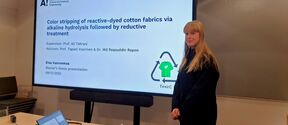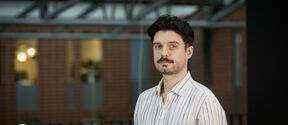Professor Tom Bäckström: Smart devices can eavesdrop and therefore we must study privacy

What do you study and why?
I study the transmission of voice and sound - for example how high-quality sound is transmitted from one telephone to another as efficiently as possible. I'm especially interested in the privacy of voice transmission. The topic is more important than ever now that smart devices are everywhere.
Voice assistants in smart devices, such as Siri and Alexa alter the privacy of spaces. You might not remember to mention to guests arriving at your home that your telephone has a voice assistant that is on. The situation might be compared with one in which a stranger is sitting in the corner listening to your conversation. You probably wouldn't want to share confidential matters out loud in a similar situation.
Before the privacy problems of voice transmission can be adequately resolved, we need to establish what privacy means and how it can be measured. Even though privacy is hard to verbalise, we intuitively recognise situations such as those in which discussing a confidential matter requires a lower volume. It's a question of social rules linked with privacy which should be applied on voice user interfaces.
To determine privacy, we have developed a new method of measurement which makes it possible to evaluate the degree of privacy and public access in public spaces. We have asked people if they feel that the space that surrounds them is the kind of area where they can tell a secret, and if the answer is yes, what kind of speech volume they would use. The ability to recognise the degree of privacy or public access of the surrounding space could be used in devices such as mobile phones in such a way that they would go into the do not disturb mode in a lecture or theatre, or would raise the volume of the ring tone in a noisy environment.
How did you become a researcher?
It was a coincidence. I studied technical physics in what was then the Helsinki University of Technology with information technology as my major. While studying I worked at an engineering company where I programmed telecommunications components into the guidance systems of electricity networks, while my friend Ville Pulkki - who was then a doctoral student and is now a professor - asked if I would be interested in working at the Department of Signal Processing and Acoustics. He knew that I had music as a hobby, and he thought that working with sound might interest me - and he was right.
What have been some of the high points of your career?
High moments include my leading role in a project which published the international 3GPP Enhanced Voice Services voice coding standard in 2014 which makes voice transfer more efficient. Consequently, nearly all phones that are less than two years old contain code that I have written. It's also wonderful that a subject that I recognize as important has finally raised interest among researchers. In the past couple of years research into privacy linked with voice transmission has been making headway and the topic is being discussed everywhere.
However, what is most gratifying on a personal level is everyday work. For a long time, I was the only expert on this topic but now I'm in the front lines taking part in the development of research, and I serve as chairman in an international cooperative organisation that has more than 70 researchers in it.
What are the characteristics that a researcher needs?
A certain type of intellectual honesty. It's not enough for something to work. The topic needs to be thoroughly understood. When something is understood completely it's easy to trust one's self even while working on the matter alone. However, this requires perseverance.
What are your expectations for the future?
I'm living in an exciting time. We have many ideas, projects, and cooperative efforts in the planning stages. The information that we have collected about people will remain relevant and it is interesting to see how it will be utilised in the future.
More information
Read more news

Master’s student showcases efficient color stripping of cotton fabrics
On December 9, master’s thesis student Elsa Vuorenmaa from the Textile Chemistry Group presented the results of her research on color stripping of reactive-dyed cotton fabrics.
Future makers research batteries, cryptography and plastic recycling
The Technology Industries of Finland Centennial Foundation awarded 3.5 million euros in research funding to eight projects, five from Aalto University.
Sebastian Szyller: I want to make machine learning more dependable and resilient to attacks
Sebastian Szyller has been appointed assistant professor at Aalto University Department of Computer Science as from 1 September 2025. He studies how to train privacy-preserving machine learning models, how to safeguard them and ensure robust predictions in untrusted environments






